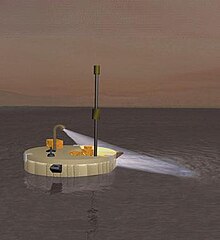Titan Mare Explorer
Titan Mare Explorer ( TiME ) was a planned lander designed to explore Saturn's largest moon, Titan . It should be the first mission to investigate an alien lake on site. TiME was proposed to NASA by Proxemy Research as a groundbreaking fact-finding mission, originally as part of NASA's Discovery & Scout Mission Capability Expansion (DSMCE) concept and study program.
The mission was a possible proposal that was submitted to NASA's Discovery program . On August 20, 2012, NASA announced that it would give preference to the Mars lander InSight over TiME and a third competitor, a comet probe. If this mission had been chosen, the planned launch window would have been January 2016. A possible alternative would be to delay TiME until it could be incorporated into the flagship TandEM (Titan and Enceladus Mission) , which is planned for the 2020s.
TiME would have been a low-cost, outer-planet mission that should directly determine the organic compounds on Titan and could have carried out the first nautical exploration of an extraterrestrial sea and, if possible, its coastlines.
As a discovery mission , TiME would have been suitable for the first use of the newly developed “ Advanced Stirling Radioisotope Generators ”, which are to be tested first on an inexpensive mission before an expensive mission.
Landing target
TiME's launch was to be made using an Atlas 411 launcher during a 21-day time window beginning January 17, 2015. Lake Ligeia Mare (78 ° N, 250 ° W) was chosen for the mission . With an extension of 100,000 km², it is one of the largest methane lakes in Titan (of those discovered so far). The replacement target is the Kraken Mare .
Mission objectives
The Titan Mare Explorer would have meant an easy flight to Titan with no orbit investigations. Measurements and data transfer should only begin after the “splashdown” (landing of the spaceship by parachute on the sea surface) of the probe. The objectives of the mission were:
- Determination of the chemical composition of the mare in order to be able to understand the methane cycle of titanium more precisely. This includes the search for the proportions of the components of the liquids and the analysis of the noble gases. Instruments: Mass Spectrometer (MS), Meteorology and Physical Properties Package (MP3).
- Determining the depth of the seas of Titan to determine their volume and hence their organic nature. Instrument: Meteorology and Physical Properties Package (Sonar) (MP3).
- Investigating Titan's fluid-related processes through characteristic physical properties of its mare and their variation with their depth below the surface. Instrument: Meteorology and Physical Properties Package (MP3).
- Determine how the local meteorology over the lakes relates to the global cycle of methane in seasonal and extended periods. Instrument: Meteorology and Physical Properties Package (MP3).
- Analyze the nature of the lake surface and, if possible, its shorelines to determine physical properties of the fluids and to gain a better understanding of their origin, evolution and methane / ethane hydrology beneath the surface of the lakes and seas of Titan Instrument: Descent and Surface Imagers (DI, SI).
Individual evidence
- ^ A b Jeremy Hsu: Nuclear-Powered Robot Ship Could Sail Seas of Titan . In: Space.com . Imaginova Corp. October 14, 2009. Retrieved November 10, 2009.
- ↑ Jonathan Amos: 'Boat' could explore Saturn moon (en) . In: BBC News , December 19, 2009.
- ↑ NASA Picks Mars Lander as Next Discovery Mission ( Memento from February 2, 2013 in the web archive archive.today )
- ↑ a b c Ellen Stofan: Titan Mare Explorer (TiME): The First Exploration of an Extra-Terrestrial Sea. (PDF; 1.4 MB) Presentation to NASA's Decadal Survey. Space Policy Online, August 25, 2009; accessed October 8, 2010 .
- ↑ Stephen Clark: NASA plans test of advanced nuclear power generator In: Spaceflight Now. May 9, 2011. Retrieved May 14, 2011.

